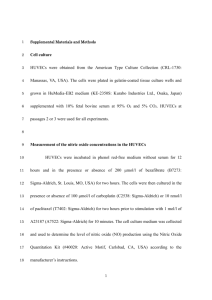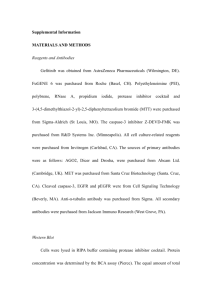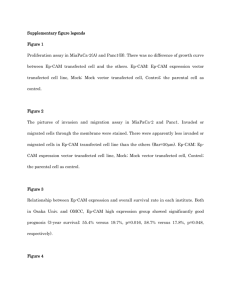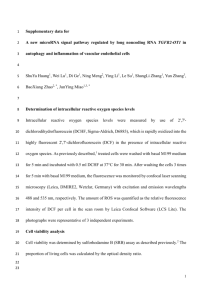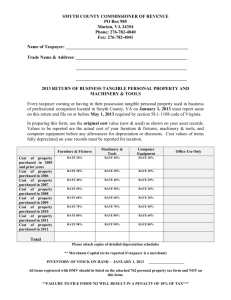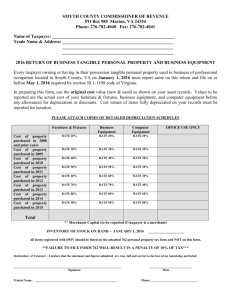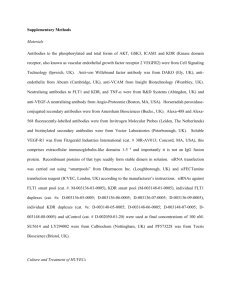Appendix
advertisement
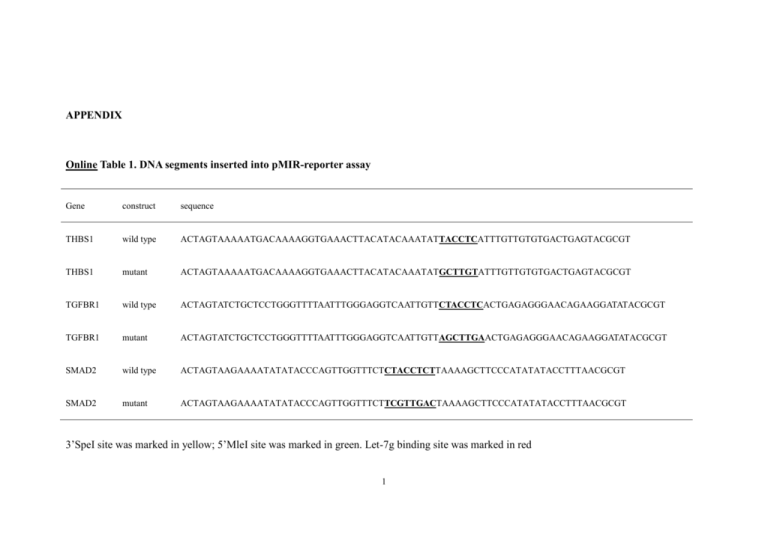
APPENDIX Online Table 1. DNA segments inserted into pMIR-reporter assay Gene construct sequence THBS1 wild type ACTAGTAAAAATGACAAAAGGTGAAACTTACATACAAATATTACCTCATTTGTTGTGTGACTGAGTACGCGT THBS1 mutant ACTAGTAAAAATGACAAAAGGTGAAACTTACATACAAATATGCTTGTATTTGTTGTGTGACTGAGTACGCGT TGFBR1 wild type ACTAGTATCTGCTCCTGGGTTTTAATTTGGGAGGTCAATTGTTCTACCTCACTGAGAGGGAACAGAAGGATATACGCGT TGFBR1 mutant ACTAGTATCTGCTCCTGGGTTTTAATTTGGGAGGTCAATTGTTAGCTTGAACTGAGAGGGAACAGAAGGATATACGCGT SMAD2 wild type ACTAGTAAGAAAATATATACCCAGTTGGTTTCTCTACCTCTTAAAAGCTTCCCATATATACCTTTAACGCGT SMAD2 mutant ACTAGTAAGAAAATATATACCCAGTTGGTTTCTTCGTTGACTAAAAGCTTCCCATATATACCTTTAACGCGT 3’SpeI site was marked in yellow; 5’MleI site was marked in green. Let-7g binding site was marked in red 1 Online Table 2. Serum let-7g levels and plasma concentrations of two biomarkers in patients of lacunar stroke (mean ± standard deviation) Subjects with low let-7g levels (N = 18) Subjects with high let-7g levels (N = 17) Student’s t test –ΔΔCt Serum let-7g ratio (2 )* 0.48 ± 0.27 Plasma PAI-1 levels (ng/ml) 5.61 ± 3.24 Plasma ADMA levels (umol/L) 0.60 ± 0.19 2.73 ± 1.36 3.70 ± 1.85 0.58 ± 0.21 p < 0.001 p = 0.04 p = 0.78 * The let-7g ratio of each stroke subject to the mean of all stroke subjects was calculated by 2-ΔΔCt where ΔΔCt was calculated by ΔCt of individual subject minus the mean of ΔCt from all stroke patients (N = 60). ΔCt was referred to Ct let-7g – CtU6B 2 Online Fig 1a. Let-7g levels in HUVECs transfected with let-7g mimic or inhibitor. The relative let-7g levels were measured using qPCR in HUVECs transfected with (A) different doses of let-7g mimic or (B) 5 nM let-7g inhibitor. Asterisk indicated significant difference in intracellular let-7g levels between cells transfected with let-7g mimic/inhibitor at the indicated doses and cells transfected with correspondent control microRNA (Student’s t-test). ** p < 0.01, * p < 0.05. 3 Online Fig 2a. Concentrations of secreted MCP-1 and IL-6 in HUVECs transfected with let-7g mimic or let-7g mimic plus TGF-1 10ng/ml. 4 Online Fig 3a. Concentrations of secreted MCP-1 and IL-6 in HUVECs transfected with let-7g inhibitor, let-7g inhibitor plus SMAD2 siRNA, let-7g inhibitor plus TGFBR1 siRNA, or let-7g inhibitor plus both SMAD2 and TGFBR1 siRNAs. Online Fig 4a. mRNA levels of PAI-1 and SMAD2 in the carotid arteries of ApoE-KO mice were measured by qPCR. Mice were injected with lentivirus carrying empty vector (empty), let-7g over-expressing plasmids (let-7g exp) or let-7g sponge plasmids (let-7g sponge) per week for the indicated period of times. HF denotes for high-fat diet containing 0.15% cholesterol. 5 Online Fig 5a. Immunohistochemistry staining indicates PAI-1 (brown color, upper panel) and pSMAD2 (brown color, lower panel) in endothelial cells of the carotid arteries of ApoE-KO mice. Mice were injected with lentivirus carrying empty vector or let-7g over-expressing plasmids (let-7g exp plasmids) per week for 12 weeks. HF denotes for high-fat diet containing 0.15% cholesterol. 6 Online Fig 6a. Network prediction for the let-7g effect on SIRT-1 The MetaCoreTM network prediction identified several possible pathways accounting for the let-7g’s effect on SIRT-1. 7 Material and Methods Target gene prediction. The TargetScan algorithm (1) was used to predict let-7g target genes. Construction of the 3’ untranslated region (UTR) reporter plasmids. The DNA segment containing the predicted let-7g binding site at the 3’UTR of each target gene and restriction enzyme sites (5’SpeI and 3’MluI) was synthesized (Online Table 1) and cloned into the 3’ end of pMIR-REPORT luciferase vector (Ambion). For the reporter assays, human embryonic kidney 293 cell line (HEK293) was transiently transfected with reporter plasmids (700 ng) carrying wild-type or mutant sequence and different doses of let-7g mimic or let-7g inhibitor using Lipofectamine 2000 (Invitrogen). pEGFP plasmids (100 ng) were co-transfected to serve as the internal control. The luciferase activity was measured using the Luc-PairTM miR luciferase assay kit (GeneCopoeia). Material. Human umbilical endothelial cells (HUVECs, C-003-5C) were purchased from Invitrogen (Grand Island, NY). HEK293 and human acute monocytic leukemia cell line (THP-1) were purchased from ATCC (Manassas, VA). The culture media including medium 200 (M200), low serum growth supplement (LSGS) and other cell culture-related reagents were purchased from Cascade Biologics (Portland, OR). 8 Ox-LDL was purchased from Biomedical Technologies (Stoughton, MA). Primary antibodies for western blot were purchased from Cell Signaling (Danvers, MA). Enhanced chemiluminescence (ECL) solution was purchased from Millipore (Billerica, MA). HiPerFect transfection reagent was purchased from Qiagen (Valencia, CA). TRIzol® reagent, Lipofectamine 2000, and secondary antibodies were purchased from Invitrogen. The kits for TaqMan microRNA assay (let-7g and RNA-U6B) and TaqMan gene expression assay (THBS1, TGFBR1, SMAD2, SIRT-1, and GAPDH) were purchased from Applied Biosystems (Foster City, CA). mirVana® miRNA let-7g mimic, inhibitor and corresponding negative controls were purchased from Applied Biosystems. The kit for Luc-PairTM miR luciferase assay was purchased from GeneCopoeia (Rockville, MD). The material for Matrigel assay was purchased from BD biosciences (Franklin Lakes, NJ). The kits for enzyme-linked immunosorbent assay (ELISA) for VCAM-1, IL-6 and PAI-1 were purchased from R & D (Minneapolis, MN). The ELISA kit for MCP-1 was purchased from BD Biosciences, and for ADMA was purchased from DLD (diagnostika GmbH, Germany). Lentiviral expression vector pCDH-CMV-MCS-EF1-GreenPuro was purchased from SBI (Mountain View, CA). Cell culture. HUVECs were grown in culture medium containing M200, LSGS, 100 9 IU/ml penicillin, and 0.1 mg/ml streptomycin. Passages 4 to 6 were used for experiments. Cell cultures were incubated at 37 ◦C in a humidified atmosphere containing 5% CO2 and 95% air for 24 hours to induce quiescence. Quantitative real-time PCR (qPCR). Extraction of total RNA was carried out using TRIzol® reagents, while reverse transcription was performed by using Superscript® III first-strand synthesis SuperMix (Invitrogen). qPCR was performed by using an ABI 7900HT Fast Real-Time PCR system with TaqMan gene expression assays (Applied Biosystems). The expression level of each target gene was calculated by using the difference in the threshold cycle method (ΔCt) with normalization to the housekeeping gene glyceraldehyde-3-phosphate dehydrogenase (GAPDH). Let-7g can be partitioned from the extracted total RNA by reverse transcription using TaqMan microRNA reverse transcriptase kit (Applied Biosystems). qPCR was then performed using TaqMan microRNA assays (Applied Biosystems), and the expression levels were calculated by using ΔCt method with normalization to RNA-U6B. Western blot analysis. Cells were harvested by cell lysis buffer (Cell signaling) containing a protease inhibitor and phosphatase inhibitor cocktail (Calbiochem). 10 Protein lysates (40g) were denatured and loaded onto a 10% SDS polyacrylamide gel. The separated proteins were then transferred onto a PVDF membrane (Millipore). The membrane was incubated overnight at 4°C in 2% BSA/PBST containing the primary antibodies. Primary antibodies against total SMAD2 (1:1000), pSMAD2 (phosphorylation site at Ser465/467, 1:1000), SIRT-1 (1:1000), and GAPDH (1:5000) were used (Cell signaling). The membrane was incubated with the secondary antibody conjugated to horseradish peroxidase. The ECL non-radioactive detection system was used to detect the antibody–protein complexes by LAS-3000 imaging system (Fujifilm, Tokyo, Japan). Blot intensity was quantitatively measured by ImageJ software (NIH). Monocyte adhesion assay. The monocyte adhesion assay was carried out using the THP-1 cells as described previously (2). After being transfected with microRNA for 24 hours, HUVECs were plated onto 96-well fluorescence plates (353948; BD). HUVECs were then treated with 40 ug/ml ox-LDL for 5 hours. THP-1 cells were washed with serum-free RPMI 1640 medium and suspended in medium with 5 μM Calcein AM (C3100MP, Invitrogen) for labeling. HUVECs were then incubated with Calcein AM–labeled THP-1 cells for 1 hour. Non-adherent THP-1 cells were removed by washing with warm RPMI 1640 medium gently. Fluorescence was measured by 11 using a fluorescence plate reader at 485 nm excitation. Matrigel assay for angiogenesis. Matrigels (BD) were thawed and placed at 37℃ for one hour before use. After being transfected with miR for 24 hours, HUVECs were seeded in matrigel-coated 24-well plate at a density of 70000 cells per well. After incubation for five hours, phase-contrast images (25x and 50x magnifications) were taken using a Zeiss Axiovert 200M microscopy (Carl Zeiss, Germany). Tubule formation was measured by counting the number of branches from randomly taken images per experimental condition. ELISA and Griess method for nitrate concentration. HUVECs were transfected with 5 nM mimic control or let-7g mimic. The supernatant of culture medium was collected at an interval of 0, 24, 48 and 72 hours post-transfection. The concentrations of VCAM-1, MCP-1, IL-6 and PAI-1 were determined by ELISA as the manufactures’ instruction using an EnSpireTM Multimode Plate Reader (PerkinElmer). eNOS activity was measured by Griess method as described previously (3). The Griess reagent (100ul) containing 0.1% N-(1-napththyl)ethylenediamine (NED), 1% sulfanilamide and 5% phosphoric acid (H3PO4) was mixed with the same volume of supernatant (100 ul) from culture medium. The supernatant of culture medium was 12 collected at an interval of 0, 24, 48 and 72 hours post-transfection with microRNAs. After being incubated in dark for 10 minutes at 37 °C, the density of the mixture of reagent and supernatant was measured at 540 nm using an EnSpireTM Multimode Plate Reader. The concentration of nitrate in the sample was determined using a calibration curve generated with standard NaNO2 solutions by a serial dilution with same volume of 0.1% NED in dH2O. The amount of total protein in the cell lysate was measured by Bio-Rad protein assay (Hercules, CA) to adjust the nitrate concentration. -Gal staining for senescence. After being transfected with microRNA for 24 hours, HUVECs were treated with 10 mM of nicotinamide (NA). The senescent status of HUVECs was assessed by the cellular senescence assay kit (Millipore) as manufacture’s instruction. Briefly, cells were incubated with the senescence Gal detection solution for 16 hours at 37°C. The reaction was stopped by removing the senescence Gal detection solution and the stained cells were washed with PBS. The percentage of -Gal stained cells was counted microscopically from randomly acquired images per experiment condition. Immuno-fluorescence stain. HUVECs were fixed with 4% paraformaldehyde and 13 permeabilized with 0.5% Triton X-100 (GIBCO-BRL). The cells were then incubated with anti–total SMAD2 antibody (1:500; Cell signaling) and AlexFluor 488 goat anti-rabbit antibody (1:500; Invitrogen). The nuclei were counterstained with 4′6-diamidino-2-phenylinodole dihydrochloride (DAPI 1:1000; Invitrogen). Fluorescence was detected by a FluoviewTM FV1000 confocal microscopy (Olympus). Stains for the carotid artery. After mice were sacrificed, the carotid arteries were removed and embedded in Sakura Tissue-Tek® O.C.T compound. The tissue was cut transversally into 8-μm serial sections and stained with mouse anti-PAI-1 antibody (1: 100 dilution; Novus Biologicals) or anti-pSMAD2 antibody (1:2000 dilution; Millipore) using the IHC Select™ kit (Millipore). Quantitative analysis of staining intensities was performed by TissueFAXS system (TissueGnostics GmbH, Australia). For immunofluorescence stain of macrophage, carotid arteries were incubated with anti-Mac-3 antibody (1:100; Millipore) and Dylight 649 conjugated goat anti-rat antibody (1:200; Rockland). Fluorescence was detected with a Leica DMI6000B microscopy (Leica Microsystems, Bannockburn, IL, USA). References 1. Lewis BP, Burge CB, Bartel DP. Conserved seed pairing, often flanked by 14 adenosines, indicates that thousands of human genes are microRNA targets. Cell 2005;120:15-20. 2. Sun X, Icli B, Wara AK, et al. MicroRNA-181b regulates NF-kappaB-mediated vascular inflammation. J Clin Invest 2012;122:1973-90. 3. Privat C, Lantoine F, Bedioui F, Millanvoye van Brussel E, Devynck J, Devynck MA. Nitric oxide production by endothelial cells: comparison of three methods of quantification. Life Sci 1997;61:1193-202. 15
